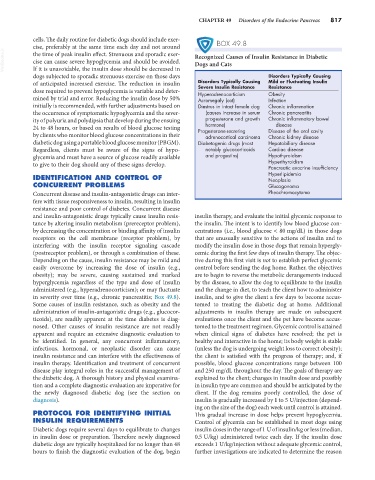Page 845 - Small Animal Internal Medicine, 6th Edition
P. 845
CHAPTER 49 Disorders of the Endocrine Pancreas 817
cells. The daily routine for diabetic dogs should include exer-
cise, preferably at the same time each day and not around BOX 49.8
VetBooks.ir the time of peak insulin effect. Strenuous and sporadic exer- Recognized Causes of Insulin Resistance in Diabetic
cise can cause severe hypoglycemia and should be avoided.
Dogs and Cats
If it is unavoidable, the insulin dose should be decreased in
dogs subjected to sporadic strenuous exercise on those days Disorders Typically Causing
of anticipated increased exercise. The reduction in insulin Disorders Typically Causing Mild or Fluctuating Insulin
Resistance
Severe Insulin Resistance
dose required to prevent hypoglycemia is variable and deter- Hyperadrenocorticism Obesity
mined by trial and error. Reducing the insulin dose by 50% Acromegaly (cat) Infection
initially is recommended, with further adjustments based on Diestrus in intact female dog Chronic inflammation
the occurrence of symptomatic hypoglycemia and the sever- (causes increase in serum Chronic pancreatitis
ity of polyuria and polydipsia that develop during the ensuing progesterone and growth Chronic inflammatory bowel
hormone)
disease
24 to 48 hours, or based on results of blood glucose testing Progesterone-secreting Disease of the oral cavity
by clients who monitor blood glucose concentrations in their adrenocortical carcinoma Chronic kidney disease
diabetic dog using a portable blood glucose monitor (PBGM). Diabetogenic drugs (most Hepatobiliary disease
Regardless, clients must be aware of the signs of hypo- notably glucocorticoids Cardiac disease
glycemia and must have a source of glucose readily available and progestins) Hypothyroidism
to give to their dog should any of these signs develop. Hyperthyroidism
Pancreatic exocrine insufficiency
IDENTIFICATION AND CONTROL OF Hyperlipidemia
Neoplasia
CONCURRENT PROBLEMS Glucagonoma
Concurrent disease and insulin-antagonistic drugs can inter- Pheochromocytoma
fere with tissue responsiveness to insulin, resulting in insulin
resistance and poor control of diabetes. Concurrent disease
and insulin-antagonistic drugs typically cause insulin resis- insulin therapy, and evaluate the initial glycemic response to
tance by altering insulin metabolism (prereceptor problem), the insulin. The intent is to identify low blood glucose con-
by decreasing the concentration or binding affinity of insulin centrations (i.e., blood glucose < 80 mg/dL) in those dogs
receptors on the cell membrane (receptor problem), by that are unusually sensitive to the actions of insulin and to
interfering with the insulin receptor signaling cascade modify the insulin dose in those dogs that remain hypergly-
(postreceptor problem), or through a combination of these. cemic during the first few days of insulin therapy. The objec-
Depending on the cause, insulin resistance may be mild and tive during this first visit is not to establish perfect glycemic
easily overcome by increasing the dose of insulin (e.g., control before sending the dog home. Rather, the objectives
obesity); may be severe, causing sustained and marked are to begin to reverse the metabolic derangements induced
hyperglycemia regardless of the type and dose of insulin by the disease, to allow the dog to equilibrate to the insulin
administered (e.g., hyperadrenocorticism); or may fluctuate and the change in diet, to teach the client how to administer
in severity over time (e.g., chronic pancreatitis; Box 49.8). insulin, and to give the client a few days to become accus-
Some causes of insulin resistance, such as obesity and the tomed to treating the diabetic dog at home. Additional
administration of insulin-antagonistic drugs (e.g., glucocor- adjustments in insulin therapy are made on subsequent
ticoids), are readily apparent at the time diabetes is diag- evaluations once the client and the pet have become accus-
nosed. Other causes of insulin resistance are not readily tomed to the treatment regimen. Glycemic control is attained
apparent and require an extensive diagnostic evaluation to when clinical signs of diabetes have resolved; the pet is
be identified. In general, any concurrent inflammatory, healthy and interactive in the home; its body weight is stable
infectious, hormonal, or neoplastic disorder can cause (unless the dog is undergoing weight loss to correct obesity);
insulin resistance and can interfere with the effectiveness of the client is satisfied with the progress of therapy; and, if
insulin therapy. Identification and treatment of concurrent possible, blood glucose concentrations range between 100
disease play integral roles in the successful management of and 250 mg/dL throughout the day. The goals of therapy are
the diabetic dog. A thorough history and physical examina- explained to the client; changes in insulin dose and possibly
tion and a complete diagnostic evaluation are imperative for in insulin type are common and should be anticipated by the
the newly diagnosed diabetic dog (see the section on client. If the dog remains poorly controlled, the dose of
diagnosis). insulin is gradually increased by 1 to 5 U/injection (depend-
ing on the size of the dog) each week until control is attained.
PROTOCOL FOR IDENTIFYING INITIAL This gradual increase in dose helps prevent hypoglycemia.
INSULIN REQUIREMENTS Control of glycemia can be established in most dogs using
Diabetic dogs require several days to equilibrate to changes insulin doses in the range of 1 U of insulin/kg or less (median,
in insulin dose or preparation. Therefore newly diagnosed 0.5 U/kg) administered twice each day. If the insulin dose
diabetic dogs are typically hospitalized for no longer than 48 exceeds 1 U/kg/injection without adequate glycemic control,
hours to finish the diagnostic evaluation of the dog, begin further investigations are indicated to determine the reason

